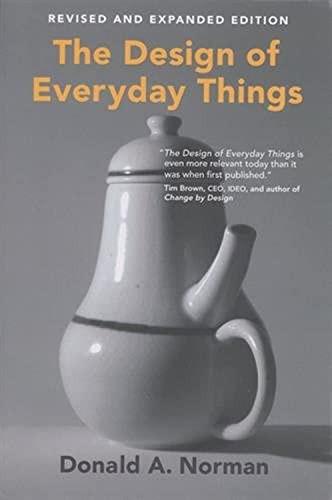Samuel Awoke's Key Ideas from The Design of Everyday Things
by Donald A. Norman
Ideas, facts & insights covering these topics:
9 ideas
·7.71K reads
53
Explore the World's Best Ideas
Join today and uncover 100+ curated journeys from 50+ topics. Unlock access to our mobile app with extensive features.
Complex Products Reflect Poor Design, Not User Error.
Have you ever found it impossible to get a new device working, like the remote control of a new TV set? If so, you’re not alone. Many people have difficulties using seemingly simple everyday products and often believe that they themselves are the problem. In actuality, the problem is bad design.
Bad design is the result of neglecting the relation between users and technology; good design brings technology and people together.
80
1.4K reads
A well-designed product teaches its users how to use it.
Most people would just say, “Read the manual!” However, user manuals are often too complex and abstract to understand.
So what’s the solution?
One way to help consumers learn how to use products is to give them clear signs or clues.
Take the example of the simple door. We don’t usually have trouble using a door: we turn the handle, and push or pull it in the direction the hinges tell us to open the door.
80
1.05K reads
...
Yet sometimes even this simple task is beyond us.
Without a sign on the door saying whether we should push or pull, even a door can be a challenge. Often, it’s not evident whether to push or pull. If the door is made of glass, has no handle, and the hinges aren’t easy to locate, we can find ourselves pushing a door in vain on the side of the hinges.
74
926 reads
The design process needs to consider human psychology.
Imagine you’re a product designer designing a new washing machine. Although it’s a common household appliance, your washing machine will need new features so it stands out from the competition. But for your users to be able to understand these new, unfamiliar features, you’ll have to take their psychology into consideration.
Users engage with a product on three different psychological levels.
77
900 reads
The different psychological levels of a user
First comes the visceral level, which corresponds to the unconscious behaviors we do without thinking, like breathing and digesting.
Next comes the behavioral level. This level includes the quick reflexes we use when we play sports, like catching a ball, or short-timed responses to actions, like pulling our hand away from a fire. These are conscious responses, but don’t allow us a lot of time to think about them.
Finally, the reflective level is the realm of conscious, higher cognitive functions where we perform complex planning and problem solving.
79
807 reads
The key to fixing bad design is to find the “root cause” of the problem.
In the old flight control model, the button to increase or decrease velocity looked the same as the button to increase or decrease the angle of descent or ascent. This led to many pilots getting confused; although it was the pilots who were making the mistakes by confusing the buttons, it was the design error of making the buttons confusing (the root cause) that led to the mistakes in the first place.
By changing the flight controls’ appearance, designers were, paradoxically, able to decrease the chances of “human error.”
76
696 reads
Good design uses product constraints to help the user understand the product.
There are cultural constraints, which are the product of shared beliefs. An example of this is the international screw standard. We all know to turn screws one way to tighten them and another to loosen. We take it for granted, but it’s this community-wide knowledge which makes the screwdriver so easy to use!
Constraints can also help remind people about important uses for the device that they may have forgotten. Imagine you’re working on a document on the computer. You work on it for many hours, but close it down without saving – big mistake!
74
646 reads
Well-designed products communicate with users by providing feedback.
Good design provides answers to the user’s questions and clarifies confusions. To do so, the device needs to communicate with users to guide them through using the device. It’s this feedback – in the form of signs, sounds and vibrations – that help the users understand the device.
74
630 reads
Successful products require patience & cooperation between marketers & designers.
Great, human-centered design isn’t enough to make a successful product on its own. For a product to be profitable, designers needs to work with other business departments.
This is the dilemma: for a product to succeed, both departments need to be in accord with one another. The product needs to be of high enough quality for the designer and profitable enough for the marketers.
77
646 reads
IDEAS CURATED BY
CURATOR'S NOTE
Good design uses human psychology to create products adapted to users’ needs and desires. Human-centered design focuses on creating products for the users, and helps users learn how to use a product, avoid dangerous errors and bring users and technology closer together.
“
Discover Key Ideas from Books on Similar Topics
5 ideas
Small Teaching
James M. Lang
5 ideas
How To Improve Your Drawing With Negative Space
informationprime.wordpress.com
11 ideas
Algorithms to Live By
Brian Christian, Tom Griffiths
Read & Learn
20x Faster
without
deepstash
with
deepstash
with
deepstash
Personalized microlearning
—
100+ Learning Journeys
—
Access to 200,000+ ideas
—
Access to the mobile app
—
Unlimited idea saving
—
—
Unlimited history
—
—
Unlimited listening to ideas
—
—
Downloading & offline access
—
—
Supercharge your mind with one idea per day
Enter your email and spend 1 minute every day to learn something new.
I agree to receive email updates









